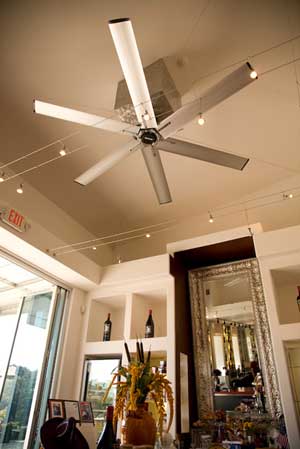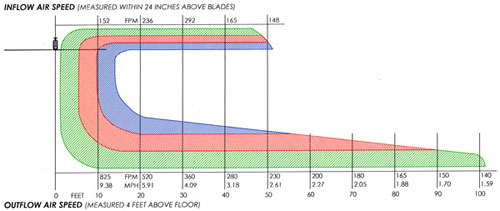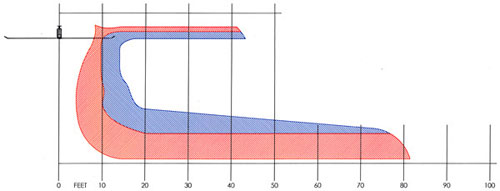HVAC for Large Spaces: The Sustainable Benefits of HVLS (High Volume/Low Speed) Fans
Learning Objectives:
- Explain how the simple physics of moving air makes HVLS fans a low energy, more sustainable alternative to traditional high-speed fan and HVAC solutions.
- Identify the numerous applications where HVLS fans offer an equal or better alternative to traditional HVAC approaches.
- Identify the design aspects and ventilation benefits of HVLS fans that contribute to sustainability and LEED® credits.
- Specify HVLS fans that efficiently meet client and user needs.
Credits:
For centuries, people living in hot climates have known the cooling powers of slowly moving air. Large ceiling fans were favored in southern antebellum dining rooms, and in British India, servants used a foot to push overhead swinging fans called punkas.
With the advent of the electric motor, fans were among the first devices to be mechanized. Thinking that moving more air was better for cooling, engineers increased the speed of fans in order to increase air displacement. But as anyone knows, a gentle breeze is cooling, while a wind is unpleasant and disruptive - as unfortunate diners in excessively cooled and draughty hotel banquet rooms will testify. Air speed beyond four or five miles per hour usually offers little, if any, additional cooling benefit. In fact, in very hot, low humidity conditions, very slow moving air cools and ventilates best.
Until a couple of decades ago, large spaces were mostly cooled by small high-speed fans that didn't cover a wide enough area. They were inefficient, consumed excessive and costly energy, and required ongoing maintenance. In 1995 mechanical engineer and race car designer Walter Boyd applied the law of physics to how ceiling fans cool and developed what are now known as High-Volume/Low-Speed, or HVLS, fans for use in large open spaces in commercial, institutional, industrial, and agricultural buildings.
For some designers, raised in the belief that cooling and heating is delivered via HVAC systems or not at all, the application of HVLS fans for cooling large spaces was, and still is, new and virtually unknown. Just as significant for engineers who are aware of the effectiveness of fans is the fact that it is the aerodynamic design of the fan blade itself that impacts airflow.
The key metric for evaluating fan effectiveness is the amount of air moved, measured in cubic feet (of air moved) per minute (CFM). Performance is based on the energy cost of moving that amount of air.
 |
Six-blade HVLS fan cools the wine tasting room in the OSO Libre Winery, Paso Robles, CA Photo courtesy of MacroAir Technologies |
The physics of cooling air is relatively simple (for a more detailed explanation see sidebar The Physics of Moving Air - on page 2). Displacement, the amount of air actually moved through a fan, is not the whole story. Instead it is the downstream effects of that air movement that are important. Also important is the fact that a large column of air travels farther than a small one. HVLS fans generate a large column of air that gently flows down to the ground and outward along the floor plane in all directions - if unimpeded - 360 degrees. The large, slow moving air mass moves throughout the space, mixing, circulating and cooling air efficiently, without generating a great deal of noise and dust.
In cooler weather, when the fan is close to the ceiling or when the direction of blade rotation is reversed, the benefits obtained for cooling are equally applicable to heating. The physics are the same, only in reverse. Warm air is mixed with cooler air and distributed efficiently (Pignet and Saxena, quoted in Report on Measurement, 23, see References).
BEING GREEN
Energy Efficiency of HVLS Fans
Calculations based on ASHRAE (American Society of Heating, Refrigerating and Air Conditioning Engineers) data and conservative facility design criteria (see Heat Savings Chart on page 7) show a five year return on investment after installing HVLS fans of $11,530 in Minneapolis, MN, and $5,350 in St. Louis, MO. In one actual 'before' and 'after' study, data show average energy cost savings averaging 49 percent plus consequent reductions in the generation of CO2 and carbon (see table: CO2, Carbon and Cost Savings After Installing HVLS Fans on page 8).
| Airflow Pattern From A 24-ft Diameter 2 Horsepower, 6-Blade Hvls Fan |
 |
Airflow nearest the fan hub (green) drops and extends over 100 feet, the furthest compared with airflow from the end of the fan (blue), which reaches only half the distance. Image courtesy MacroAir Technologies |
| Airflow Pattern Resulting From 24-ft 2 Horsepower Blade With Winglets |
 |
Airflow drawn into the fan (red and blue) drops with an irregular flow and extends a shorter horizontal distance compared with the airflow moved by a fan with no winglets. Note the absence of air dropping close to the fan's hub (no green). (Santolucito, see References) Image courtesy MacroAir Technologies |
HVLS fans are best suited for large, mostly open spaces with a minimum ceiling height of 15 feet. Studies by mechanical efficiency experts (Report on Measurement, see References) show that HVLS fans are the most energy efficient air circulating fans available. High-speed fans focus on using their speed to increase air displacement. According to the fan laws, a common subset of the laws of physics, the power to drive a fan is equal to the cube of the speed. If you double the speed of a fan, it requires (2 times 2 times 2) or 8 times the amount of electrical power. For example, a high speed commercial fan delivering air at 20 mph requires about 64 times as much power as one of the same size delivering air at five mph. HVLS fans, on the other hand, focus on using size, not speed, to move air. The Air Movement and Control Association International (AMCA), the body that certifies fan performance has defined airflow (CFM) as a function of fan diameter and thrust. Under this AMCA formula, increasing either diameter or thrust results in an increase in CFM; increasing thrust requires more input power, while increasing diameter does not. Regardless of diameter, all HVLS fans in the same series (for example, 1 HP fans) use the same motor and draw approximately the same current through the controller. This means that doubling the size of a fan requires less than twice the power.










